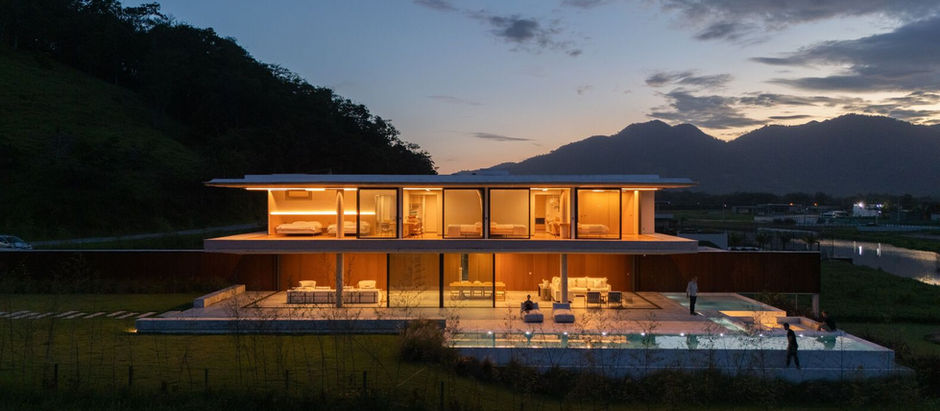

What are Smart Buildings?
OpDez Architecture designs Smart Buildings for the cities of tomorrow.
As the first new building typology to emerge since the last industrial revolution, Smart Buildings represent the built environment’s response to the 21st-century technological transformation. In an era defined by decentralization and digital innovation, OpDez Architecture leads the way—delivering energy-independent, intelligent spaces that elevate quality of life and redefine how people interact with cities around the world.
NexGen Buildings: The Future of Architecture by OpDez
As the world advances deeper into the age of automation, digitization, and decentralized systems, the built environment must evolve to meet new expectations. Buildings today must do more than provide shelter. They must operate intelligently, produce their own power, respond to user needs in real time, and adapt to future technologies.
At OpDez Architecture, this evolution is embodied in a proprietary design and operational framework known as NexGen Buildings. These structures integrate robotics, artificial intelligence, decentralized control systems, smart building technologies, and energy autonomy, forming self-regulating ecosystems optimized for performance, resiliency, and occupant experience.
This article presents the technological foundation of NexGen Buildings and outlines how OpDez Architecture is redefining the built environment using Web3 principles, digital twins, and a closed-loop design strategy.
Energy Independence and Closed Loop Systems
NexGen Buildings begin with energy independence as a baseline requirement. Every building is engineered to produce, store, and manage its own energy on-site using a combination of:
-
Photovoltaic solar panels
-
Vertical-axis wind turbines
-
Geothermal heating and cooling loops
-
Hydrogen fuel cells
-
Next-gen energy storage systems
Depending on site-specific conditions, hybrid systems are deployed to ensure consistent performance, with backup energy handled by local storage or grid-interactive contracts. Building envelopes are optimized to reduce heating and cooling loads through passive design, thermal mass, and high-performance glazing.
These systems feed into a closed-loop energy architecture, in which waste energy is recovered and reused wherever possible. Smart meters and load balancing algorithms allow the structure to dynamically shift energy to the areas of greatest demand while prioritizing storage and efficiency.
Complementing energy loops, water and waste systems also follow closed-cycle principles. Gray water from showers and sinks is filtered and reused in toilet systems or irrigation. Rainwater is collected and stored on-site, and bio-waste is repurposed via digesters or composting units. All systems are designed to reduce utility dependency and enhance building autonomy.
Embedded Intelligence: AI, IoT, and Predictive Automation
Every NexGen Building is embedded with distributed IoT architecture from foundation to roof. These sensors gather continuous, real-time data on:
-
Temperature and humidity
-
Air quality and particulate levels
-
Occupancy and movement
-
Lighting and sound levels
-
System performance across HVAC, electrical, water, and mechanical units
This data is processed locally and in the cloud via artificial intelligence systems tailored to each building’s configuration. Unlike traditional building automation, OpDez’s AI-driven BMS uses deep learning to predict occupant behavior, weather changes, energy demand spikes, or maintenance events—adjusting systems proactively.
For example, the system may recognize that a conference room fills every Monday morning and begins pre-conditioning the air 30 minutes in advance. Lighting, shading, and HVAC adjust automatically throughout the day based on occupancy and user preferences.
In combination with edge computing nodes, buildings can operate independently of remote cloud platforms when needed, ensuring continuity and security in operations.
Robotics Integration: Service, Façade, and Operations
Robotics form an active layer in NexGen Building systems. This includes both mobile and static robotic components embedded within the building or operating autonomously throughout it:
-
Facade cleaning robots navigate curtain walls of high-rises
-
Interior cleaning bots operate on scheduled or condition-based routes
-
Autonomous delivery bots transport goods between floors or buildings
-
Robotic window shades and louver arrays track sunlight and adjust position
These systems interface directly with the building’s AI controller and allow real-time task delegation without human intervention. In complex projects such as hospitals, labs, and data centers, robotics significantly improve operational consistency and reduce the need for repetitive manual tasks.
Web3 Integration and Blockchain-Based Control
Where most buildings rely on proprietary control systems and third-party management, NexGen Buildings operate on a Web3-native framework. Every major service function, energy management, leasing, access control, maintenance scheduling, and data exchange, is governed by blockchain-based smart contracts.
These contracts are executed on high-throughput, low-energy distributed ledger platforms such as Hedera Hashgraph. This enables real-time coordination between building systems and external actors (utilities, tenants, vendors) with full transparency and automation.
Key blockchain-enabled features include:
-
Decentralized energy trading between buildings
-
Access credentials via digital identity tokens
-
Tokenized leasing and service agreements
-
DAO governance of building decisions
OpDez has minted 10 million OpDez tokens for use in this ecosystem. These tokens allow stakeholders—whether owners, operators, or tenants—to participate in building-level governance, pay for services, or access digital assets linked to real-world infrastructure.
AR and Digital Twin Technology
From design through operation, NexGen Buildings are modeled and maintained using high-resolution digital twins. These are not static 3D models—they are real-time, synchronized, multi-layered replicas of the building's systems, architecture, and usage patterns.
-
During design, digital twins allow accurate simulation of energy flows, daylighting, and human circulation.
-
During construction, they guide sequencing and clash detection.
-
After commissioning, they serve as the operational backbone of the building.
The digital twin integrates directly with an AR interface, which provides occupants, maintenance personnel, and operators with instant visibility into system status, spatial data, or user preferences. Through wearable AR devices or mobile apps, users can:
-
View hidden systems behind walls (e.g., pipe runs, conduit, valves)
-
Navigate complex buildings with AR wayfinding
-
Adjust room settings by interacting with virtual panels
-
Access building analytics in spatial context
This interface elevates transparency and interaction in building environments and creates new workflows for management and occupant experience.
Tokenized Real Estate and Fractional Ownership
NexGen Buildings are also designed to be tokenized as real-world assets (RWAs). Through compliant fractionalization structures, a single property can be divided into digital tokens that represent:
-
Equity ownership
-
Revenue rights
-
Voting rights within a building DAO
Token holders can vote on capital improvements, select service vendors, or receive a share of building-generated revenue. These tokens are tradeable across regulated digital asset marketplaces, allowing increased liquidity, reduced entry costs, and global accessibility for real estate investment.
This model transforms real estate from a static, illiquid asset into a dynamic, programmable one. It also allows communities to own portions of buildings collectively, and for developers to raise capital more flexibly.
Zero Point Energy and Next-Level Innovation
OpDez Architecture maintains a research-oriented approach to frontier technologies. Among these, Zero Point Energy (ZPE) stands as a long-term speculative concept. While ZPE is still in theoretical or experimental stages, its principles are being explored in tandem with energy harmonics, magnetic resonance, and vacuum energy models.
OpDez supports design environments that allow for ZPE prototyping integration, such as dedicated zones for experimental energy modules, harmonic oscillation dampeners, and closed magnetic chambers.
These future-forward facilities are not part of all projects, but in select innovation hubs and research complexes, OpDez embeds infrastructure that can support experimental energy research.
Privacy-First Architecture and Data Ownership
As data becomes a core component of modern buildings, privacy and control are non-negotiable. NexGen Buildings implement data sovereignty at the architectural level. Occupants and system operators retain control over what is collected, who can access it, and how it is used.
Using zero-knowledge proofs, end-to-end encryption, and localized edge processing, data is kept secure and under the control of its rightful owner. Building systems anonymize and process data without exporting identifiable information to third parties.
For example, an AI-based lighting system may know a space is occupied but not who is occupying it, unless explicit permission is granted.
Modular and Upgradable Systems
Because innovation is continuous, NexGen Buildings are designed to be modular and upgradeable. Key systems such as HVAC, electrical panels, energy storage units, and IoT controllers are installed in plug-and-play racks or vertical risers.
If better technology becomes available—say, a new battery chemistry or updated communications standard—components can be replaced without major construction. This design approach ensures the building retains its value and functionality across decades.
Engineering the Future
NexGen Buildings by OpDez Architecture are a deliberate response to the demands of a high-performance, digital-first, and decentralized future. These are buildings engineered as intelligent systems, optimized for self-sufficiency, transparency, and long-term adaptability.
With robotics, AI, Web3 technologies, smart energy systems, and digital twins as core layers, OpDez is not simply building structures—it is developing living infrastructure capable of autonomous operation, community governance, and digital-physical integration.
Each NexGen Building represents a platform for innovation, a node in a broader ecosystem of responsive architecture, and a model for how built environments can evolve in tandem with human progress—without political framing, just pure performance, function, and foresight.
Explore the Collection
Discover our premium gear for performance and durability. Designed for work, sport and adventure, it’s perfect for those who move with purpose.































